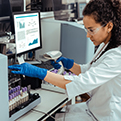
Getty Images /yacobchuk
Two sessions on December 17 at the 2020 AACC Annual Scientific Meeting & Clinical Lab Expo offer deep dives into laboratory information systems (LIS), with insights on automation and analytic solutions and on using LIS to improve operational efficiencies and patient outcomes.
First on the day’s agenda is Total Laboratory Automation Analytics Solutions—Friend or Foe? (35111), a session that runs from 11 a.m.–12:30 p.m. and is worth 1.5 ACCENT credit hours. Attendees will learn about the emerging field of clinical laboratory analytics and emerging useful tools, said co-presenter Edward Leung, PhD, DABCC, FACB, FADLM, assistant professor of clinical pathology at the University of Southern California Keck School of Medicine.
He and David McClintock, MD, associate professor of informatics in the Department of Pathology at Michigan Medicine, will cover the different informatics issues that arise when selecting and implementing a clinical laboratory analytics platform, and the different types of total laboratory automation analytics platforms. Attendees will also learn how to identify components of these systems to assist with specific use cases.
According to Leung, labs should consider the following elements in choosing lab automation platforms:
- Vendor/platform reputation.
- Local vendor support.
- Technology used (is the platform going to be updated soon?).
- Quality of the assays and reagents.
- Ease of use (i.e., maintenance, instrument software, hands-on time, etc.).
- Is the complete platform available (are some key components still pending regulatory approval?).
- Space/infrastructure requirements.
- Open versus closed system (can instruments from other vendors be added to the system?).
- IT/connectivity requirements.
Good communication and getting the right people involved at the right time is key in implementing lab automation, said Leung. He also recommended that labs engage good project managers, involve IT support as early as possible—and plan for delays. “There will always be some unforeseen issues,” he added. Labs should consider space/infrastructure requirements, major changes to workflow and potential staffing changes, and having all instruments, reagents, specimens, and IT infrastructures in place.
An afternoon session, Leverage Laboratory Information Systems to Improve Operational Efficiency and Patient Care (35227), explores the tools and rules for setting up user-defined programs in LIS. Speakers will demonstrate steps in evaluating needs, building, implementing, and surveilling.
Ila Singh, MD, PhD, chief of Texas Children’s Hospital’s Division of Laboratory Medicine, will speak on quality metrics dashboards and intra-lab communication tracking by user-defined programs. In a two-part presentation, Herbert Whinna, MD, PhD, an associate professor at the University of North Carolina at Chapel Hill School of Medicine, and Bulent Oral, IT director of New York Presbyterian Hospital, will discuss the journey to automated critical value calls generated from LIS and bumps they experienced along the way in implementing this functionality.
Labs aren’t taking advantage of LIS in several areas, the speakers told CLN Stat. “I think laboratories can get more out of analytical reports and real-time dashboards. Labs can establish command centers to oversee entire operations,” said Oral. “Unfortunately, I feel the lab industry is still departmentalized in their operations even though core laboratories support more robust operations using robotics systems.”
Singh noted three other ways in which labs underutilize LIS:
- Providing real-time information on tests that are about to exceed their stated turnaround time.
- As a mechanism to flag major problems that might affect different parts of a lab, such as an issue with deionized water or lack of people to staff the call center.
- As a mechanism to flag major problems to a practitioner ordering a test. Examples include: instrument downtime that might affect turnaround time significantly, a reagent recall that needs rerouting to a different laboratory, or a pneumatic tube shutdown that will affect specimen transport.
“I think there are layers to the LIS system functionalities, and they should be defined within each layer,” noted Oral. System hardware, redundancy, and recoverability should provide the foundation for LIS. Laboratory backbone operations from patient registrations, order entry, result entry, result auto verification, online quality control, and specimen collection automation should all be well defined. “There is good work being done around cloud usage as an option these days,” added Oral. However, specimen collection automation remains a common challenge in the industry.
Oral would like the session to serve as a starting point for discussing the operational challenges of LIS. “Laboratorians are being forced to come out of their shell. They should be included in cross-departmental collaborations to resolve multiple operational issues,” he emphasized.
Singh hopes her talk will generate interest in using information systems that provide more efficient ways to communicate data across laboratories. She’ll discuss several methods for doing this. The first approach involves dashboards that track metrics and allows labs to drill down into outliers. “The second will be a custom-built application that allows people to communicate across sections of the laboratory that may be geographically distant from each other—allowing people to get out of their silos to do what is best for our patients,” she said.
Functionalities introduced in this session “are potentially scalable to other organizations because they are based on commercially available informatic systems,” said session moderator Jing Cao, PhD, DABCC, assistant professor of pathology at the University of Texas Southwestern Medical Center. “However, local IT expertise is needed to adopt these functionalities.”
Following this session, participants should be able to:
- Describe the LIS elements that allow data storage, transmission, and exchange between analyzers and electronic medical record systems.
- List available options for extracting and presenting quality metrics from LIS and documenting inter-lab communication.
- Evaluate the impact of automating critical value calls on both laboratory and clinical care teams.
This session takes place from 2–3:30 p.m. and is worth 1.5 ACCENT credit hours.